Did you know that you can connect to your Power BI Desktop
Model from Sql Server Management Studio (SSMS)?
If not, this blog post is for you.
In this blog post I will be showing you how to connect to
your Power BI Model that you have opened with Power BI Desktop from SSMS.
Whenever I try to Get Data in Power BI, I always closely
monitor the Task Manager for Memory usage.
I always notice that there is the Microsoft Sql Server
Analysis /services and Power Bi Desktop applications top the memory usage as
shown below.
What this means is Power BI Desktop uses Sql Server Analysis
Services for getting data into its memory. Even though your local system does
not have SSAS installed, it uses the msmdsrv executable that’s in the bin folder
of the Power BI Desktop folder as shown below:
So there is a close connection between Power BI Desktop and
SSAS.
Now coming to the actual content of this blogpost – In order
to connect to the Power BI Desktop model from SSMs, you need to know the exact port that the local instance of SSAS is
running. To find out this port, follow
the below steps –
Step 1 Open the
Power BI Desktop model you are trying to access from SSMS using the Power BI
Desktop application (October 2017). I used the Power BI Desktop application optimized for
Power BI Report Server.
Step 2 Now browse to
the Local App data folder using the path below –
C:\Users\username\AppData\Local\Microsoft\Power
BI Desktop SSRS\AnalysisServicesWorkspaces\AnalysisServicesWorkspace422556974\Data
If you are using the regular Power BI Desktop model the
local appdata folder will be as below
C:\Users\username\AppData\Local\Microsoft\Power
BI Desktop\AnalysisServicesWorkspaces\AnalysisServicesWorkspace422556974\Data
Step 3. In the above
folder locate a text file named msmdsrv.port.txt as shown below :
Step 4 Open the file
and copy the number of the port that is displayed.
Step 5 Now open SSMS
and connect to Analysis services by giving localhost:portnumber as shown below :
It uses Windows Authentication to connect to the model.
Step 6 Now you can
see the databases and associated tables in the model as shown below.
There you go ... You are now connected to your Power BI Model using SSMS.



















